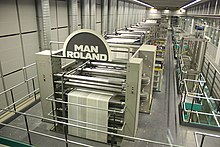Offset printing: Difference between revisions
→Present day: added HP Indigo to more accurately reflect the range of digital presses |
→Offset printing advantages: it's the price per page that drops in function of the volume not the total price |
||
| Line 8: | Line 8: | ||
* Quick and easy production of printing plates. |
* Quick and easy production of printing plates. |
||
* Longer printing plate life than on direct litho presses because there is no direct contact between the plate and the printing surface. |
* Longer printing plate life than on direct litho presses because there is no direct contact between the plate and the printing surface. |
||
* The more you print, the less you pay, because most of the price goes into the preparation undergone before the first sheet of paper is printing and ready for distribution. Any additional paper print will only cost the client paper price (and ink), which is very minimal. |
* The more you print, the less you pay per page, because most of the price goes into the preparation undergone before the first sheet of paper is printing and ready for distribution. Any additional paper print will only cost the client paper price (and ink), which is very minimal. |
||
* High speed and high volume printing. |
* High speed and high volume printing. |
||
Revision as of 10:15, 7 May 2008
| Part of a series on the |
| History of printing |
|---|
 |
Offset printing is a widely used printing technique where the inked image is transferred (or "offset") from a plate to a rubber blanket, then to the printing surface. When used in combination with the lithographic process, which is based on the repulsion of oil and water, the offset technique employs a flat (planographic) image carrier on which the image to be printed obtains ink from ink rollers, while the non-printing area attracts a film of water, keeping the non-printing areas ink-free.
Offset printing advantages
Advantages of offset printing compared to other printing methods include:
- Consistent high image quality. Offset printing produces sharp and clean images and type more easily than a than letterpress printing because the rubber blanket conforms to the texture of the printing surface.
- Quick and easy production of printing plates.
- Longer printing plate life than on direct litho presses because there is no direct contact between the plate and the printing surface.
- The more you print, the less you pay per page, because most of the price goes into the preparation undergone before the first sheet of paper is printing and ready for distribution. Any additional paper print will only cost the client paper price (and ink), which is very minimal.
- High speed and high volume printing.
Photo offset
The most common kind of offset printing is derived from the photo offset process, which involves using light-sensitive chemicals and photographic techniques to transfer images and type from original materials to printing plates.
In current use, original materials may be an actual photographic print and typeset text. However, it is more common — with the prevalence of computers and digital images — that the source material exists only as data in a digital publishing system.
Offset litho printing on to a web (reel) of paper is commonly used for printing of newspapers and magazines for high speed production.
Sheet-fed litho
Offset litho printing on to single sheets of paper or board. Commonly used for printing of short run magazines, brochures, letter headings, general commercial (jobbing) printing.
Present day

Offset printing is the most common form of high-volume commercial printing, due to advantages in quality and efficiency in high-volume jobs. While modern digital presses (Xerox iGen3 Digital Production Press or the family of HP Indigo solutions, for example) are getting closer to the cost/benefit of offset for high-quality work, they have not yet been able to compete with the sheer volume of product that an offset press can produce. Furthermore, many modern offset presses are using computer to plate systems as opposed to the older computer to film workflows, which further increases their quality.
In the last two decades, flexography has become the dominant form of printing in packaging due to lower quality expectations and the significantly lower costs in comparison to other forms of printing.
References
- "Offset Printing". Encyclopædia Britannica. Retrieved March 22, 2004, from Encyclopædia Britannica Premium Service.[1]
- History of Lithography. International Paper.
- HistoryWired: Rubel Offset Lithographic Press. Smithsonian National Museum of American History.
- Raidy Printing Group. The History of Printing.
